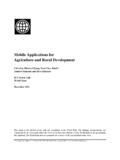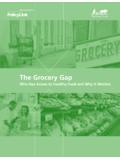Transcription of biogas
1 biogas HANDBOOK. Downloaded from biogas HANDBOOK. Colophon Authors Teodorita Al Seadi, Dominik Rutz, Heinz Prassl, Michael K ttner, Tobias Finsterwalder, Silke Volk, Rainer Janssen Reviewers Dominik Rutz, Teodorita Al Seadi, Konstantinos Sioulas, Biljana Kulisic Editing Teodorita Al Seadi English proof reading and layout Stud. MA Catrineda Al Seadi, Stud. MSc Iwona Cybulska ISBN 978-87-992962-0-0. Published by University of Southern Denmark Esbjerg, Niels Bohrs Vej 9-10, DK-6700 Esbjerg, Denmark Cover design by Catrineda Al Seadi Cover photo: Copyright 2008 Typeset with Word All rights reserved. No part of this book may be reproduced in any form or by any means, in order to be used for commercial purposes, without permission in writing from the publisher or the authors.
2 The editor does not guarantee the correctness and/or the completeness of the information and the data included or described in this handbook. Acknowledgement This handbook was elaborated through the joint efforts of a group of biogas experts from Denmark, Germany, Austria and Greece, as part of the BiG>East project, (EIE/07/214 ), running during the period , with the overall aim of promoting the development of biogas from anaerobic digestion in Eastern Europe. The project was co-funded by the European Commission, in the framework of the Intelligent Energy for Europe Programme. The English version of the handbook was subsequently translated into Bulgarian, Croatian, Greek, Latvian, Romanian and Slovenian, which are the languages of the countries targeted by the BiG>East project.
3 These translated versions contain also a supplementary chapter of country specific information. The editor thanks all the authors, the reviewers and the two talented students for their contribution to the handbook and for the great team work. Teodorita Al Seadi October 2008. 2. biogas HANDBOOK. Table of contents COLOPHON ..2. TABLE OF AIM AND HOW TO USE THE HANDBOOK ..9. WHAT IS biogas AND WHY DO WE NEED IT?.. 10. 1 ADVANTAGES OF biogas TECHNOLOGIES ..10. BENEFITS FOR THE SOCIETY ..10. Renewable energy Reduced greenhouse gas emissions and mitigation of global Reduced dependency on imported fossil Contribution to EU energy and environmental targets ..11. Waste reduction ..11. Job creation ..12. Flexible and efficient end use of biogas .
4 12. Low water inputs ..12. BENEFITS FOR THE FARMERS ..12. Additional income for the farmers Digestate is an excellent Closed nutrient Flexibility to use different feedstock ..13. Reduced odours and Veterinary safety ..14. 2 biogas FROM AD - STATE OF ART AND POTENTIAL ..14. AD STATE OF ART AND DEVELOPMENT TRENDS ..14. biogas POTENTIAL ..15. 3 MORE ABOUT ANAEROBIC DIGESTION (AD) ..16. SUBSTRATES FOR THE BIOCHEMICAL PROCESS OF Hydrolysis ..22. Acidogenesis ..22. AD PARAMETERS ..23. Temperature ..23. pH-values and optimum Volatile fatty acids (VFA) ..26. Ammonia ..27. Macro- and micronutrients (trace elements) and toxic compounds ..27. OPERATIONAL Organic load ..27. Hydraulic retention time (HRT)..28.
5 Parameter list ..28. 4 MAIN APPLICATIONS OF AGRICULTURAL biogas PLANTS ..30. 3. biogas HANDBOOK. Family scale biogas Farm-scale biogas Centralised (joint) co-digestion WASTE WATER TREATMENT PLANTS ..37. MUNICIPAL SOLID WASTE (MSW) TREATMENT PLANTS ..38. INDUSTRIAL biogas PLANTS ..38. LANDFILL GAS RECOVERY PLANTS ..39. 5 UTILISATION OF biogas PROPERTIES ..41. DIRECT COMBUSTION AND HEAT UTILISATION ..42. COMBINED HEAT AND POWER (CHP) GENERATION ..42. Gas-Otto engines ..43. Pilot-injection gas motor ..44. Stirling motors ..44. biogas MICRO-TURBINES ..45. FUEL CELLS ..45. biogas UPGRADING (BIOMETHANE PRODUCTION) ..47. biogas as vehicle fuel ..48. Biomethane for grid injection ..49. Carbon dioxide and methane production as chemical 6 UTILISATION OF AD - A TECHNOLOGY FOR ANIMAL MANURE AND SLURRY MANAGEMENT IN INTENSIVE AREAS 50.
6 FROM RAW SLURRY TO DIGESTATE AS FERTILISER ..51. Biodegradation of organic Reduction of Sanitation ..52. Destruction of weed seeds ..52. Avoidance of plant burns ..52. Fertiliser APPLICATION OF DIGESTATE AS FERTILISER ..53. EFFECTS OF DIGESTATE APPLICATION ON SOIL ..54. PRACTICAL EXPERIENCES ..55. DIGESTATE Strategies of digestate conditioning ..55. Necessary DIGESTATE QUALITY MANAGEMENT ..58. Digestate sampling, analyzing and product Nutrient management in General measures for quality control and safe recycling of digestate ..59. 7 biogas PLANT FEEDSTOCK RECEIVING UNIT ..63. FEEDSTOCK STORAGE AND CONDITIONING ..63. Feedstock Feedstock FEEDING SYSTEM ..67. Pumps for transport of pumpable feedstock.
7 68. Transport of stackable ARMATURES AND PIPELINES ..72. HEATING SYSTEM - DIGESTER Batch-type digesters ..75. Continuous-type Maintenance of digesters ..79. 4. biogas HANDBOOK. STIRRING TECHNOLOGIES ..80. Mechanical stirring ..80. Pneumatic Hydraulic stirring ..82. biogas STORAGE ..82. Low pressure tanks ..83. Medium and high pressure biogas storage ..84. biogas biogas CLEANING ..86. Gas Desulphurization ..87. Drying ..90. DIGESTATE THE CONTROL UNIT ..92. Quantity of pumpable feedstock input ..94. Digester filling level ..94. Filling level of the gas Process temperature ..94. pH-value ..94. Determination of volatile fatty acids (VFA)..95. biogas biogas HOW TO GET STARTED .. 96. 8 PLANNING AND BUILDING A biogas PLANT.
8 96. SETTING UP A biogas PLANT PROJECT ..96. HOW TO SECURE CONTINUOUS FEEDSTOCK SUPPLY ..98. Characterising the plant size for farm based feedstock ..98. Characterising the plant size for industrial/ municipal wastes ..99. Feedstock supply WHERE TO LOCATE THE biogas PLANT ..101. GETTING THE START UP OF A biogas PLANT ..102. 9 SAFETY OF biogas PLANTS ..103. FIRE AND EXPLOSION PREVENTION ..103. POISONING AND ASPHYXIATION RISKS ..104. OTHER RISKS ..105. SANITATION, PATHOGEN CONTROL AND VETERINARY ASPECTS ..105. Hygienic aspects of biogas plants ..105. Parameters for hygienic performance of biogas plants ..106. Indicator Requirements for sanitation ..109. 10 ECONOMY OF biogas PLANTS ..111. FINANCING THE biogas ECONOMIC FORECAST OF A biogas PLANT PROJECT.
9 112. Conclusions of economic forecast of the biogas plant ANNEXES .. 114. ANNEX 1. GLOSSARY, CONVERSION UNITS AND ABBREVIATIONS ..114. GLOSSARY ..114. CONVERSION UNITS ..119. ABBREVIATIONS ..120. 5. biogas HANDBOOK. ANNEX 2. ANNEX 3. ADDRESS LIST OF AUTHORS AND REVIEWERS ..125. 6. biogas HANDBOOK. Foreword One of the main environmental problems of today's society is the continuously increasing production of organic wastes. In many countries, sustainable waste management as well as waste prevention and reduction have become major political priorities, representing an important share of the common efforts to reduce pollution and greenhouse gas emissions and to mitigate global climate changes. Uncontrolled waste dumping is no longer acceptable today and even controlled landfill disposal and incineration of organic wastes are not considered optimal practices, as environmental standards hereof are increasingly stricter and energy recovery and recycling of nutrients and organic matter is aimed.
10 Production of biogas through anaerobic digestion (AD) of animal manure and slurries as well as of a wide range of digestible organic wastes, converts these substrates into renewable energy and offers a natural fertiliser for agriculture. At the same time, it removes the organic fraction from the overall waste streams, increasing this way the efficiency of energy conversion by incineration of the remaining wastes and the biochemical stability of landfill sites. AD is a microbiological process of decomposition of organic matter, in the absence of oxygen, common to many natural environments and largely applied today to produce biogas in airproof reactor tanks, commonly named digesters. A wide range of micro-organisms are involved in the anaerobic process which has two main end products: biogas and digestate.






